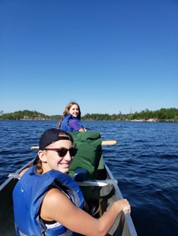In a research brief I co-authored with Kristina Abbas, we outline eight key components for creating inclusive and impactful outdoor learning experiences. In a series of three blog posts, I will offer additional explanations and resources of these eight components:
- A sense of safety and support
- An environment for positive, social support
- An invitation to explore
- A guided experience in nature
- Ability to break away from normal life
- Activities to foster self-awareness
- Challenge
- Intensity
A sense of safety and support
In our effort to ensure a safe and supportive environment for young people, we must start with the foundation of the Weikart's Youth Program Quality Pyramid, in which the very hearts and minds of young people are protected to the best of our program design and environmental structure. Creating a sense of safety and support goes beyond physical safety, although foremost, program staff must ensure that proper risk management policies are in place and communicated to all involved in youth programming. As new programs and outdoor experiences are created, risk management and policies should be reviewed to cover all situations.
Supportive environments engage young people in learning. New-to-the-outdoors or audiences from cultures of historical trauma and a fear of outdoor spaces may require additional support. Activities that introduce the outdoors in small doses are essential to establish comfort and confidence while being outdoors as well as build trust in the leaders' levels of competency. The Avarna Group outlines an extensive list of inclusion tips for program staff, many which will foster a supportive environment for all young people in the outdoors. Using inclusive language from the beginning of the program, making sure all participants have adequate gear to use, and celebrating diversity are just a few of the tips that foster a supportive environment.
An environment for positive, social support
Program staff also need to design intentional and quality learning environments that foster an environment for positive, social support. As young people engage in longer and more intense outdoor experiences, there is an opportunity for young people to receive feedback and acceptance from others as they learn and live in a community, creating a sense of social responsibility. As explained in The Youth Adventure Programming Model, "An intense, dynamic, and yet supportive social setting also encourages collective reflection on previous tasks and planning for upcoming tasks, an important part of the psychological change process."
As designers of outdoor programs, trust activities and team building are important elements to build rapport between young people and also with adult leaders. Developing a group contract together can also form agreement and accountability within the group. Program staff should also be able to facilitate conflict resolution as young people try out new roles and rely on each other through wilderness experiences.
Looking at your outdoor programs, how is the design structured to uphold safe and supportive environments? What elements would you need to consider to bolster more social support for the groups you serve?
Join me next week as we explore the components of providing an invitation to explore, a guided experience in nature, and the importance of the ability to break away from normal life!
You are welcome to comment on this blog post. We encourage civil discourse, including spirited disagreement. We will delete comments that contain profanity, pornography or hate speech--any remarks that attack or demean people because of their sex, race, ethnic group, etc.--as well as spam.

Comments
Post a Comment